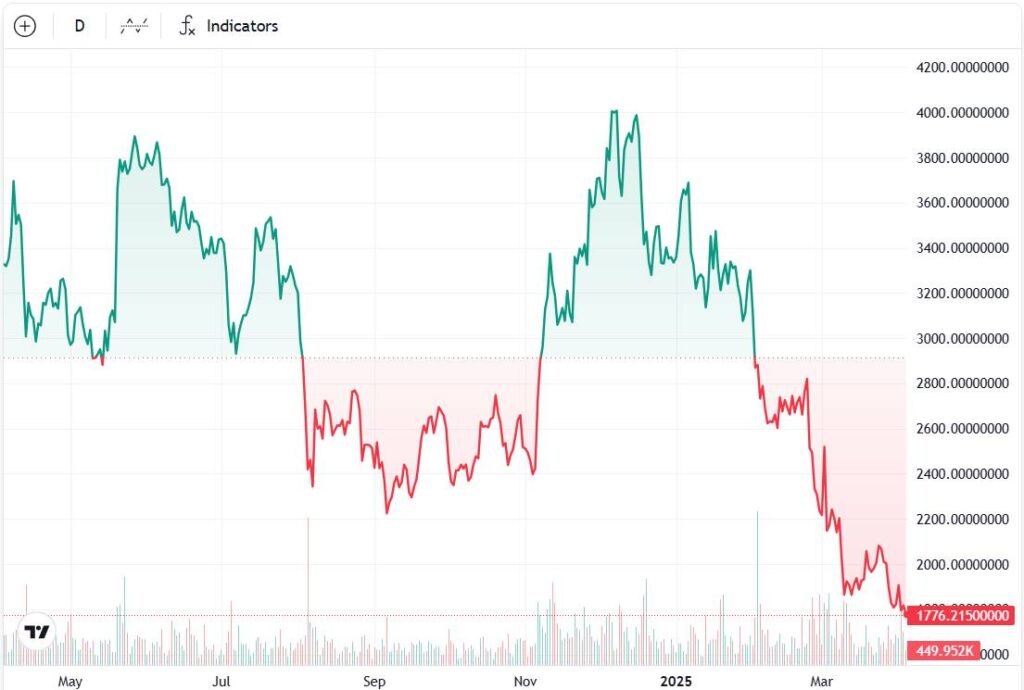The cryptocurrency landscape is currently experiencing a complex shift, characterized by a remarkable increase in stablecoin supply amidst a cautious atmosphere among investors. According to a recent report from the crypto intelligence platform IntoTheBlock, the stablecoin supply surged by over $30 billion in the first quarter of 2025, reaching new all-time highs. This uptick occurred even as the broader cryptocurrency market saw a decline of 19% in its total market capitalization.
“The correlation between crypto and stocks climbed as macro expectations quickly shifted from ‘golden era’ optimism to tariff-led doom and gloom,” reported IntoTheBlock.
Increases in stablecoin supply often reflect investor caution. As Juan Pellicer, a senior research analyst at IntoTheBlock, noted, many traders are holding stablecoins as a protective measure, potentially waiting for market conditions to stabilize or for more favorable entry points. This trend hints at a significant transformation in market sentiment as stakeholders grapple with uncertainties, including the looming specter of US tariffs.
Industry experts have suggested that if the current trajectory continues, the total supply of stablecoins could exceed $1 trillion by the end of 2025, marking an unprecedented shift in the crypto market. “We’re in a stablecoin adoption upswell that’s likely to increase dramatically this year,” stated Pakman during a recent live show, emphasizing the potential for robust growth in this sector.
“We could go from $225 billion stablecoins to $1 trillion just this calendar year,” Pakman added.
Interestingly, in conjunction with the surge in stablecoins, the Ethereum network experienced a significant uptick in activity, with over $3 trillion worth of stablecoin transactions recorded on its mainnet. For the first time, unique addresses utilizing stablecoins on Ethereum eclipsed the 200,000 mark. Despite this increased activity, Ethereum’s ether (ETH) prices faced a steep decline, dropping over 45% during the same quarter. Analysts suggest that this downturn can be attributed to broader macroeconomic concerns and heightened competition from alternative networks such as Solana.
“The decline in ETH is more likely due to market sentiment and uncertainty about Ethereum’s ability to capture value from its broader ecosystem,” Pellicer explained.
As the cryptocurrency market grapples with these challenges, some analysts cautiously predict a potential rebound. Nansen’s research suggests a 70% likelihood that the crypto markets may find a bottom by June 2025 as tariff negotiations unfold, indicating that the landscape may soon shift once again.
Impact of Stablecoin Growth Amid Market Volatility
The recent surge in stablecoin supply highlights a significant trend in cryptocurrency investor behavior and market dynamics, with potential implications for both individual investors and the broader financial landscape.
- Stablecoin Supply Surge
- The total supply of stablecoins rose by over $30 billion in the first quarter of 2025.
- This growth occurred despite a 19% decline in overall cryptocurrency market capitalization.
- Investor Caution
- Investors are adopting a cautious approach, holding stablecoins as a hedge against market instability.
- This behavior indicates a wait-and-see strategy, potentially impacting liquidity and market movements.
- Predictions for Stablecoin Growth
- Industry leaders anticipate that stablecoin supply could exceed $1 trillion in 2025, potentially acting as a significant market catalyst.
- The increasing adoption of stablecoins suggests a bullish sentiment may return in the future.
- Ethereum Network Activity
- Ethereum’s network saw over $3 trillion in stablecoin transactions during the first quarter.
- Unique addresses using stablecoins on Ethereum surpassed 200,000, indicating growing participation in the blockchain ecosystem.
- Despite this activity, the price of Ether (ETH) fell by over 45% due to broader economic concerns.
- Market Sentiment and Future Outlook
- macroeconomic factors and rising competition from other networks are contributing to ETH’s price decline.
- Analysts predict a 70% likelihood that crypto markets will stabilize by June 2025 as tariff negotiations progress.
“We’re in a stablecoin adoption upswell that’s likely to increase dramatically this year.” – Market analyst
Stablecoin Surge Amidst Market Turmoil: A Comparative Insight
The recent surge in stablecoin supply, reaching an unprecedented $30 billion within a single quarter, paints a captivating picture of resilience within the cryptocurrency sector. Yet, this impressive growth stands in stark contrast to the broader crypto market, which has experienced a 19% decline in market capitalization. Unlike previous cycles characterized by exuberance and optimism—often dubbed the “golden era”—current conditions are steeped in uncertainty, especially as US tariff fears loom large. This juxtaposition raises important questions about the evolving landscape of stablecoins and their implications for various stakeholders.
Competitive Advantages: The growth in stablecoin supply signifies a strategic move by investors who are adopting a more cautious approach, opting to hold stablecoins as a hedge against market volatility. This behavior suggests an increasing demand for stability in an unpredictable environment. Furthermore, prominent figures in the industry predict that the stablecoin supply could easily surpass the $1 trillion mark this year, potentially serving as a significant catalyst to rejuvenate the crypto market. This upswing in stablecoin activity, particularly on platforms like Ethereum, illustrates a robust infrastructure that can facilitate substantial transaction volumes while maintaining user engagement.
Competitive Disadvantages: However, the optimism surrounding stablecoins is tempered by notable challenges. The Ethereum network, despite its significant role in stablecoin transactions, faces increased competition and pressures that have driven its native cryptocurrency, Ether, down by over 45%. This decline is not just a metric of Ethereum’s performance—the environment is riddled with uncertainties that could hinder the long-term adoption and price appreciation of stablecoins, especially when juxtaposed with alternatives like Solana and various layer-2 solutions that may dilute Ethereum’s dominance.
For investors and crypto enthusiasts, the current environment presents dual perspectives. On one hand, those seeking to hedge against volatility can find refuge in stablecoins, anticipating potential market recovery as tariff negotiations progress. Conversely, traders focused on high-risk, high-reward investments might find this cautious climate unappealing, leading to potential missed opportunities as they await more bullish signals.
Industry Stakeholders, particularly those within the Ethereum ecosystem, may need to pivot their strategies in light of these trends. While the influx of stablecoin capital could provide a much-needed boost, the underlying pressures on Ether could complicate matters for developers and investors alike. As the market evolves, clear strategies will be essential to leverage the upswing in stablecoin activity while mitigating risks posed by macroeconomic factors.
In summary, while the explosive growth of the stablecoin sector may offer a beacon of hope, it also carries a complex set of implications that could either bolster or challenge the broader cryptocurrency landscape. Engaging in this dynamic environment requires nuanced understanding and strategic foresight.

















